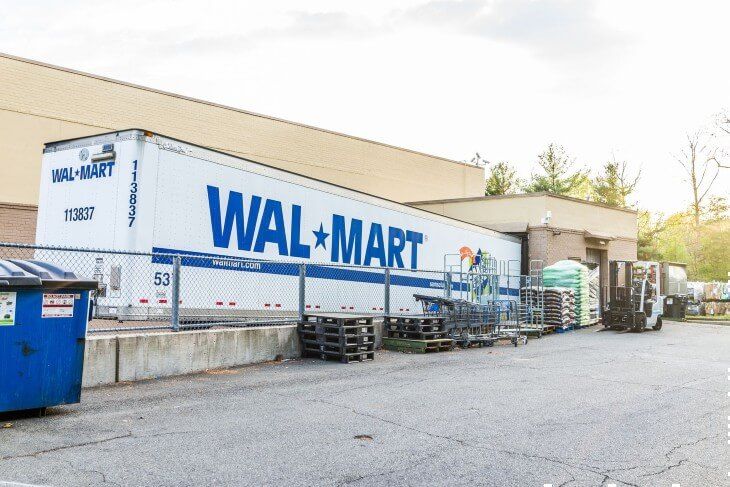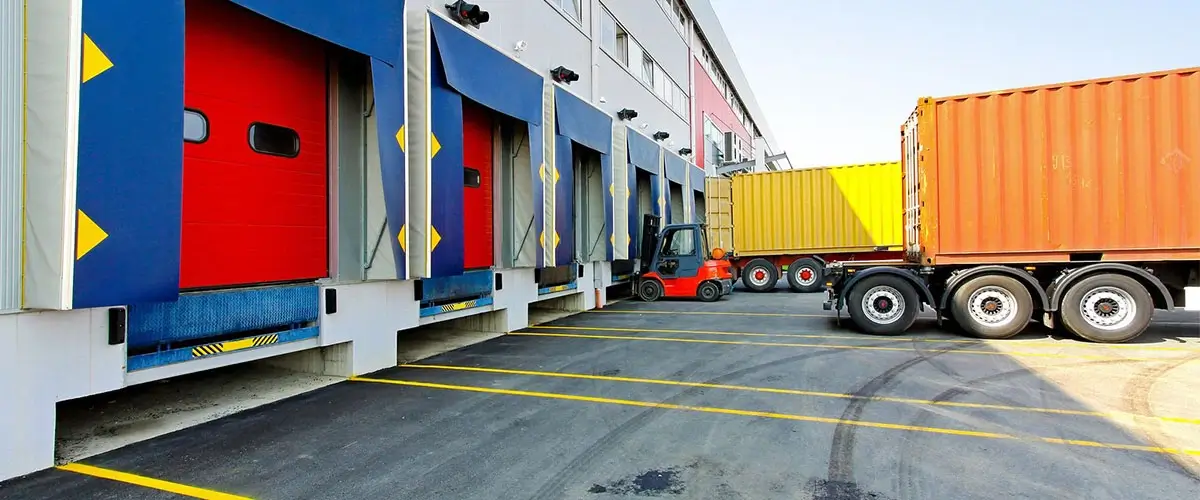Key Takeaways:
- Cross-docking is a warehouse strategy that reduces waste and tied-up capital by minimizing inventory storage and ensuring faster turnover.
- While cross-docking requires significant upfront investment, it can potentially save long-term costs such as storage, labor, and inventory management.
- Not every industry benefits equally from cross-docking. Industries like automotive, food and beverage, consumer goods, and chemicals often see significant benefits from this strategy.
- Implementation of cross-docking requires careful planning, scheduling, and coordination, often necessitating a specialized warehouse management software.
- Wal-Mart is a prime example of a company that has successfully implemented cross-docking, leading to their dominance in the retail industry.
An Intro to Cross-Docking: Is It Right For My Business?
You can use cross-docking to reduce warehouse waste and free up capital tied in inventory management. How does that happen? Cross-docking allows you to keep less inventory in your warehouse, and to experience faster inventory turnover.
Incoming goods are sorted and processed at your receiving dock before quickly leaving on an outgoing transport vehicle.
What makes this so special? Typically, incoming goods are processed, sorted, and then stored in your warehouse where they are kept until needed. Cross-docking drastically reduces and, in some cases, entirely eliminates the need for warehousing.
As companies and consumers span borders, streamlining a global supply chain is an essential part of your business strategy. Multinational corporations like Unilever, McDonald’s, and Nestle are only a few examples of companies who invest heavily in supply chain improvements and innovations. A clunky supply chain that locks money in inventory management hinders a business’ ability to grow and beat its competitors.
Cross-docking is one strategy that can allow your company to boost its warehouse cost efficiency. It isn’t perfect for every business, but it can be transformative for some.
In our cross-docking guide guide, we’ll help you understand:
BONUS: Before you read further, download our Warehouse Management Software Whitepaper to see how Logiwa uses real-time data to help you get up to 100% inventory accuracy and execute advanced fulfillment strategies like cross-docking.
In other words, you’ll have the information needed to determine whether cross-docking is right for your business.
What Is The Difference Between Cross-Docking and Warehousing?
To explain cross-docking, we’ll quickly review warehousing.
Today, supply chain managers and strategists view warehouses as a problem to be managed. Terms like motion waste, labor costs, and inventory mismanagement are regularly thrown around. Indeed, some people believe human-run warehouses will be eliminated altogether, although that probably won’t happen anytime soon.
Contrary to their current portrayal, warehouses were once considered a place that served efficiency. In order to meet fluctuations in consumer demand, businesses used warehouses to store excess goods to keep product moving through their supply chain. The amount of time it took to get an order to the manufacturer or supplier, and then to the customer, simply took too long.
But despite being necessary, warehousing introduced increased costs for:
- Storage space and taxes
- Storage space heating and lighting
- Labor costs for inventory management
- Insurance and taxes

Developments in communication technology, logistics, transportation, and enterprise resource management tools reduced the need for large quantities of stock. Businesses could opt for buffer stock or no inventory at all through Just-in-Time manufacturing, also known as lean manufacturing.
Today, some goods don’t go into stock at all and move purely through what’s known as the cross-docking process.
In a cross-docking scenario, the warehouse, or distribution center, serves as the “hub” in a hub-and-spoke model. Received goods are quickly sorted, processed, and placed onto trucks bound for different destinations. Companies are effectively reducing both inventory and warehouse material handling.
What Does A Cross-Docking Operation Consist Of?
Specific cross-docking operations vary by company. Moreover, supply chain managers are still in the process of optimizing cross-docking systems to automate the many manual steps that currently exist. At the basic level, cross-docking uses the same equipment as traditional warehousing, such as a loading dock, pallets, containers, and forklifts.
Researchers have outlined a cross-docking solution based on a three-step approach to cross-docking operations to optimize the process. This includes:
- Planning
- Scheduling
- Coordination platform design
| Stage | Activities | Objective |
| Planning |
Identification of containers with pallet exchange relationships to create groups Identification of related containers within a group to create clusters Calculation of minimum number of doors needed to process a group without re-admitting them through the cross-dock Allocation of groups to docks to achieve the least amount of movement of pallets |
|
| Scheduling |
Use planning outputs (groups, cluster, minimum number of doors) as input for scheduling module Trigger re-scheduling module of scheduling tool when changes to input are detected to create a more suitable schedule |
|
| Coordination Platform Design |
Use of three main modules:
Definition and documentation of master cross-docking scenario and related assumptions Task assignments, processes, location and distance norms, and resource specifications incorporated into system |
|
With the right warehouse technology, you don’t have to analyze your data and create a cross-docking management plan from scratch. A warehouse management software (WMS) is essential for running a successful cross-docking operation.
That said, buyers should conduct research into the capabilities of different WMS tools. While every WMS should provide the essential tools and information for cross-docking, some will make the process easier than others.
A cross-docking WMS tool benefits from the following capabilities:
- Electronic Advance Ship Notice (ASN) Transmission: Provides real-time data on inbound and outbound goods
- Barcode Scanning: Reduces manual data entry and increases inventory accuracy rates by seamlessly integrating information from computers, UPC barcode scanners, etc.
- Parsing ADC devices: Breaks down barcode and inputs into WMS to reduce manual entry
- Incoming Freight Management: Tools for inputting data from received goods into the system (e.g. barcode scanner)
- Business Intelligence: Tracking inventory and analysis to understand what is happening within your warehouse, including a breakdown of warehouse KPIs
- Disaster Recovery: A backup system to ensure business continuity
- Workforce Planning Capabilities: Tracking and reporting features that breakdown scheduling and task management data to ensure operations and outcomes are aligned with warehouse workforce planning objectives
Better Warehouse Performance = Higher Profit Margins: Logiwa syncs accurate data across your entire interface so the inventory numbers you see on your dashboard are what your employees see on their devices. Learn how Logiwa uses real-time data to help you get up to 100% inventory accuracy and 2.5x shipments.
What Are The Advantages of Cross-Docking?
- Reduces storage space: On average, businesses spend $6.53 per square foot of warehouse space. Reducing storage space contributes to cost savings and the reduction of your company’s carbon footprint.
- Reduces inventory costs: Inventory management ties up much-needed capital. It costs money to store, manage, count, secure, and insure inventory. Moreover, money is lost when excess inventory spoils or gets damaged. Cross-docking reduces the amount of goods held over the long term.
- Reduces material handling: Cross-docking minimizes the movement of goods around the warehouse either manually or automatically. Traditional warehouse operations consist of significant inventory handling, such as sorting, storing, picking, and packing.
- Increases product quality: While staging products (temporarily keeping them on the dock while processing them before shipping) workers can easily inspect products for damages from transport vehicles. This reduces the number of damaged products shipped to customers, saving money on returns and maintaining customer satisfaction.
- Reduces labor costs: Labor is one of the most challenging costs to control. Cross-docking helps reduce the number of people needed to manage inventory, and those savings can be passed on to customers or put into other process improvement projects.
- Reduces damage from material handling: Sometimes damage is due to material handling, not bumpy transport vehicles. As the movement of goods decreases, the likelihood of damaged goods decreases as well.
- Reduces delivery times: Cross-docking facilities are often located in areas near the client’s final delivery destination, thereby reducing delivery times.
- Increased service levels: Minimizing product damage, lowering the cost to consumers, and reducing delivery times all lead to improved service levels. This is especially important in a B2B environment with specific service level agreements.
- Reduce transportation costs: By using the best possible route, transport vehicles travel fewer miles, therefore reducing overall transportation costs.
- Reduces overall fixed costs: In addition to storage space, there are other fixed costs (e.g. equipment, utilities) that exist within large warehouses. Reducing the amount of storage space also reduces the amount of money spent on lighting, heating, equipment, and more.
What Are The Disadvantages of Cross-Docking?
- It Can Be Time-consuming: If cross-docking isn’t properly planned, scheduled, and executed it can be incredibly time-consuming. While it sounds like a seamless solution (quickly move inbound goods to an outbound transport vehicle) it takes time to process everything. Goods should not spend more than 24 hours in a warehouse or distribution center. Well-oiled cross-docking operations can sometimes move goods in and out in a matter of hours.
- Capital investment: Establishing an effective cross-docking operation requires a significant upfront investment. While a business realizes cost savings in the long term, setting up cross dock terminals is expensive.
- Requires supplier trust: Cross-docking relies on a “just-in-time” philosophy to manufacturing and shipping. If your suppliers routinely fail to send the correct products or quantities, it hinders your ability to fulfill orders, eroding customer trust. It also wastes time and reduces productivity.
- Requires Transport Vehicles: Cross dock operations need a large number of transport vehicles to service your inbound and outbound dock.
- Risk of Shrinkage: While cross-docking can reduce damage due to reduced material handling there is still the possibility of shrinkage (theft or damage) if there aren’t proper procedures in place.
What Types of Businesses are Suited for Cross-Docking?
Cross-docking has numerous benefits, but it’s expensive to implement. How can you determine whether this strategy is most suitable for your business?
As it happens, your industry may provide a clue. It turns out some industries reap more benefits, more quickly, from cross-docking than others.
- Automotive Industry: Car manufacturers traditionally rely on just-in-time delivery and have been using cross-docking for decades. Indeed, the lean manufacturing model, otherwise known as just-in-time manufacturing, was pioneered by Toyota and was originally referred to as the “Toyota Production System”.
- Food and Beverage Industry: Restaurants need a constant supply of ingredients for their menu items. Moreover, the increased chances of inventory spoilage make cross-docking a smart alternative. Rather than spending money on expensive temperature-controlled inventory management, companies can move food items quickly through the supply chain.
- Consumer Goods: Why is Amazon so successful? Because it has almost everything people need, at costs they love, and the goods arrive quickly. It’s hard for competitors to keep up. While Amazon can afford to take a financial hit on shipping fees, many businesses can’t, preventing them from offering the same speed at the price consumers have grown accustomed to. Cross-docking helps companies meet consumer demands faster and at a lower cost.
- Chemicals: Chemical products are the definition of “high maintenance inventory”. Their specific storage requirements make them expensive and potentially dangerous. Minimizing inventory handling by getting them to the end customer sooner rather than later is the ideal scenario and cross-docking enables this.
If your business would benefit significantly from minimal warehousing, then cross-docking may be for you.
Be mindful, however, that wanting your products to move quickly may not be enough to justify switching to cross-docking.
Cross-docking is most effective for companies who move a high volume of goods by enabling them to consolidate shipments from various sources and ship them to their end users via the best route.
Wal-Mart: A Famous Example of Cross-Docking Success
For decades, business students have studied Wal-Mart’s supply chain management. Routinely beating competitors like K-Mart and Sears in terms of distribution costs, Wal-Mart prioritized supply chain cost reduction from Day 1 in order to keep costs low for consumers.

Indeed, Wal-Mart is one of the most famous examples of a company that uses cross-docking. Wal-Mart trucks pull up to distribution centers and goods are retrieved, processed, and sent to stores that are typically within 130 miles from the distribution center. This strategy has been enormously successful for the retailer and has contributed to their dominance in the industry.
Cross-Docking Is a Potentially Lucrative Supply Chain Strategy for Your Business
Cross-docking presents significant cost savings opportunities. Nevertheless, retailers, distributors, and manufacturers shouldn’t view it as a panacea. Implementing a cross-docking operation requires a careful examination of your industry, the investment of necessary upfront costs, and the willingness to develop a comprehensive standard operating procedure.
Logiwa is the WMS you need to execute advanced warehouse operations in your warehouse, like cross-docking. Schedule your free WMS demo today.
FAQS: Warehouse Cross Docking
Q: What is warehouse cross docking?
A: Warehouse cross docking is a logistics strategy where incoming goods are sorted and processed at the receiving dock before quickly being dispatched on an outgoing transport vehicle. This approach reduces the need for warehousing and allows for faster inventory turnover.
Q: How does warehouse cross docking differ from traditional warehousing?
A: Traditional warehousing involves storing goods until they’re needed, which can increase storage costs and tie up capital in inventory management. On the other hand, warehouse cross docking reduces and in some cases eliminates the need for warehousing as goods are quickly processed and dispatched to their next destination.
Q: What are some benefits of warehouse cross docking?
A: Warehouse cross docking can reduce storage and inventory costs, minimize the movement of goods in the warehouse, improve product quality, decrease labor costs, lower delivery times, increase service levels, and reduce overall fixed costs.
Q: Are there any drawbacks to warehouse cross docking?
A: Yes, despite its many benefits, warehouse cross docking can be time-consuming if not properly planned and executed. It requires a significant upfront investment, a large number of transport vehicles, and a high degree of trust with suppliers. There’s also a risk of shrinkage if proper procedures are not in place.
Q: Can all businesses benefit from warehouse cross docking?
A: Not all businesses will benefit equally from warehouse cross docking. It is particularly effective for industries like automotive, food and beverage, consumer goods, and chemicals, which often deal with high volume goods and benefit significantly from minimal warehousing.
Q: Are there any famous examples of successful warehouse cross docking?
A: Yes, Wal-Mart is a well-known example of a company that has successfully implemented warehouse cross docking. This strategy has significantly contributed to their cost reduction efforts and industry dominance.
Q: Do I need any special tools or software for warehouse cross docking?
A: Yes, running a successful cross-docking operation often requires a warehouse management software (WMS) that can handle planning, scheduling, and coordination of cross-docking operations. The WMS tool should offer features like real-time data on inbound and outbound goods, barcode scanning, business intelligence, and disaster recovery among others.
The Leading Supply Chain Management Software for “New Age” B2C/B2B Fulfillment Businesses
Warehouse Management
Modern digital WMS powers a modern fulfillment experience






